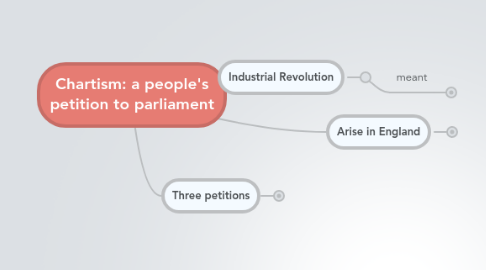
1. Arise in England
1.1. Chartism aims was present a people's charter, or petition for reform
2. Industrial Revolution
2.1. meant
2.1.1. Traditional rural comunities declined
2.1.2. Working-class urban population growth
2.1.3. Living a working conditions were appalling
2.1.4. Arose certain movements aimed at bettering working-class conditions
2.1.5. One such movement was Chartism
3. Three petitions
3.1. In 1838 it ussued a charter whith six political reforms for the LWMA that was founded by William Lovett -first petition-
3.1.1. Outcome of the first petition- 1839
3.1.1.1. Delegates collected signatures for a great petition
3.1.1.2. Petition was rejected in parliament by a large majority
3.1.1.3. National Convention proclaimed a general strike
3.1.1.3.1. One week later cancelled the proclamation
3.1.1.3.2. The government sent troops where Chartism had more strength
3.2. 1842 second petition
3.2.1. Outcome of the second petition
3.2.1.1. Parliament again rejected by 287 votes to 49
3.2.1.2. Riots and strikes followed
3.2.1.3. The government sent troops where Chartism had more strength
3.2.1.4. many Chartists were arrested
3.2.1.5. William Lovett subsequently abandoned the moviment
3.2.1.6. Fergus O'Connor became the new leader Chartist
3.3. 1848 third Chartist petition ‘Monster Petition’
3.3.1. Outcome of the third petition
3.3.1.1. Government took elaborate military precautions -forbidden to cross the Thames-
3.3.1.2. The Chartist movement was discredited
3.3.1.2.1. the petition had less signatures that said by the leader
3.3.1.3. Gave expression to a number of proposals which were later adopted to produce a reformed parliamentary system
3.3.1.4. The process of reform not fully achieved until the early 20th century

